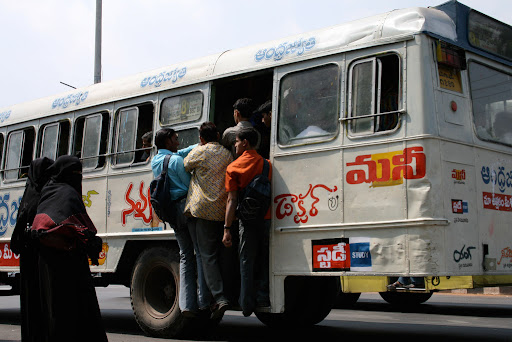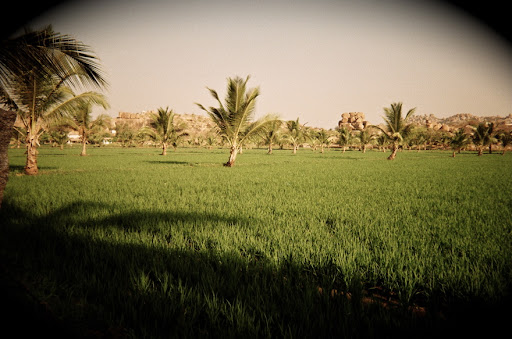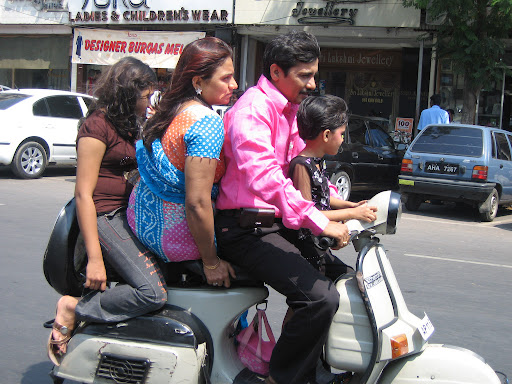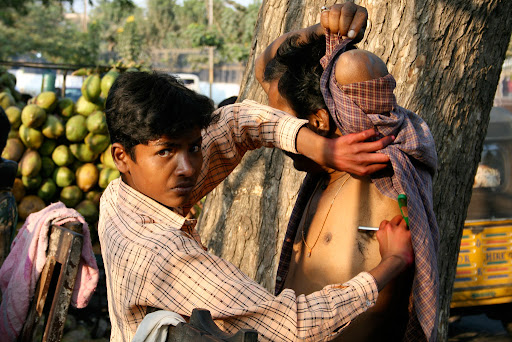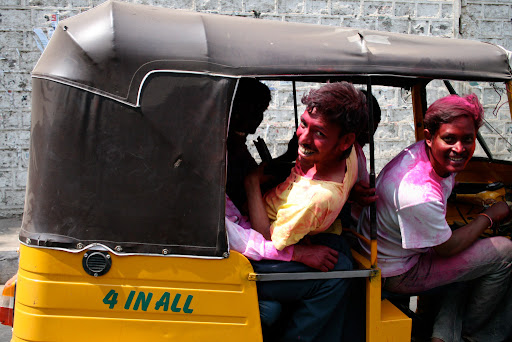Bihar.. bizarre!
Siliguri,

 To make a long story short, Bihar is a different world. I wouldn't have been so surprised if that had been my entry point in India, expecting a third-world country. But after having driven 8000 km in a dozen different states, on mostly acceptable to good roads, I'm impressed by the generally good infrastructure of India. After all it's a very rich country, developing incredibly quickly. But Bihar is taking a back seat to this process and the roads there are amazingly bad. Indeed, they're on a par with the worst roads of Siberia and Kyrgyzstan, and I'm talking about (what is described as) major highways. They should learn something from the Mongolians, who know that bad tarmac is worse than no tarmac at all. Even the Grand Trunk Road, a link between Delhi an Kolkatta is in a pretty bad state of repair. Crossing the cities were not any better, as they are easily the filthiest and most chaotic I've seen in India yet. The sign posting is inexistent or in Hindi only at best, so the GPS was at least as useful as in the middle of Mongolia.
To make a long story short, Bihar is a different world. I wouldn't have been so surprised if that had been my entry point in India, expecting a third-world country. But after having driven 8000 km in a dozen different states, on mostly acceptable to good roads, I'm impressed by the generally good infrastructure of India. After all it's a very rich country, developing incredibly quickly. But Bihar is taking a back seat to this process and the roads there are amazingly bad. Indeed, they're on a par with the worst roads of Siberia and Kyrgyzstan, and I'm talking about (what is described as) major highways. They should learn something from the Mongolians, who know that bad tarmac is worse than no tarmac at all. Even the Grand Trunk Road, a link between Delhi an Kolkatta is in a pretty bad state of repair. Crossing the cities were not any better, as they are easily the filthiest and most chaotic I've seen in India yet. The sign posting is inexistent or in Hindi only at best, so the GPS was at least as useful as in the middle of Mongolia.
 Unlike central Asia, the road are busy with thousands of trucks, buses, jeeps and tractors. Cars are rare, and the buses are always overcrowded, including the roof which apparently is not the worst place. Shared jeeps are heavily used also, and of course the roof is put to good use. I counted once 11 people on the roof and 8 hanging outside, in addition to the indeterminate number packed inside, which is more typical than a record. And as if the roof wasn't that busy already, they still manage to strap on it a loudspeaker blasting heavily distorted music. Go figure.
Unlike central Asia, the road are busy with thousands of trucks, buses, jeeps and tractors. Cars are rare, and the buses are always overcrowded, including the roof which apparently is not the worst place. Shared jeeps are heavily used also, and of course the roof is put to good use. I counted once 11 people on the roof and 8 hanging outside, in addition to the indeterminate number packed inside, which is more typical than a record. And as if the roof wasn't that busy already, they still manage to strap on it a loudspeaker blasting heavily distorted music. Go figure.
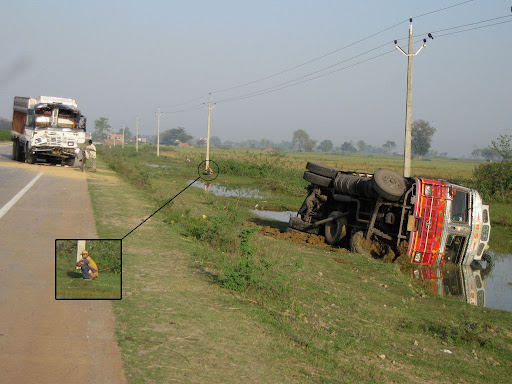 To be fair I didn't feel insecure at all in the 3 days I spent there, despite the stories of bandits and Maoists rebels roaming the state. Driving conditions notwithstanding, as you feel happy every night to be still alive, after fighting with the worst drivers of all India and dodging the suicidal pedestrians (run down somebody and the next thing you have to do is run for your life, as the locals may well try to finish you off).
To be fair I didn't feel insecure at all in the 3 days I spent there, despite the stories of bandits and Maoists rebels roaming the state. Driving conditions notwithstanding, as you feel happy every night to be still alive, after fighting with the worst drivers of all India and dodging the suicidal pedestrians (run down somebody and the next thing you have to do is run for your life, as the locals may well try to finish you off).
 People are just as friendly as in the rest of India, although the conversations are quickly put to an end by the language barrier. Literally nobody in the state speaks English, and the most literate of them would only manage to go as far as "country ?", "mileage ?", "price ?", etc.. By that time I'm pretty used to people surrounding me (or, should I say, my bike) as soon as I pull over. In Bihar though, it takes a different dimension, as the crowd quickly grows to several dozens people, to the point of disrupting the nearby traffic. They mostly stare without speaking, but eventually somebody will go with the usual questions, straight in Hindi as is seems quite inconceivable to them that somebody wouldn't understand it.
People are just as friendly as in the rest of India, although the conversations are quickly put to an end by the language barrier. Literally nobody in the state speaks English, and the most literate of them would only manage to go as far as "country ?", "mileage ?", "price ?", etc.. By that time I'm pretty used to people surrounding me (or, should I say, my bike) as soon as I pull over. In Bihar though, it takes a different dimension, as the crowd quickly grows to several dozens people, to the point of disrupting the nearby traffic. They mostly stare without speaking, but eventually somebody will go with the usual questions, straight in Hindi as is seems quite inconceivable to them that somebody wouldn't understand it.
 It may be the least touristy state in India, but it still boasts a couple attractions. I left the Grand Trunk Road to reach Bodh Gaya, where Buddha lived and taught. The whole place is built up with fancy hotels for the millions of Buddhist pilgrims coming from as far as Thailand and Japan. The touts quickly put me off so after a quick photo in front of the huge statue of Buddha I left for Rajgir, which was supposed to be nice and quieter. That turned out to be a mistake as the site was pretty boring and the I got lost going there, misled by fuzzy directions in that big mess of a city which Gaya is, so I ended up on a secondary road. As it goes, in Bihar, take anything less than a highway and you have to ford rivers as they "forget" to mention on the maps that the bridges are in construction. And with 2 people and a run-down caterpillar, it may take them another 10 years to finish it up.
It may be the least touristy state in India, but it still boasts a couple attractions. I left the Grand Trunk Road to reach Bodh Gaya, where Buddha lived and taught. The whole place is built up with fancy hotels for the millions of Buddhist pilgrims coming from as far as Thailand and Japan. The touts quickly put me off so after a quick photo in front of the huge statue of Buddha I left for Rajgir, which was supposed to be nice and quieter. That turned out to be a mistake as the site was pretty boring and the I got lost going there, misled by fuzzy directions in that big mess of a city which Gaya is, so I ended up on a secondary road. As it goes, in Bihar, take anything less than a highway and you have to ford rivers as they "forget" to mention on the maps that the bridges are in construction. And with 2 people and a run-down caterpillar, it may take them another 10 years to finish it up.
 The electricity supply there is as bad as the roads, with frequent power cuts (so that means a diesel engine running the whole night below your hotel room so that the staff can watch cricket). Granted, that's the case in many other places in India, but here it's so bad that they don't even bother putting lampposts in the towns and at night the streets fall into darkness, lit only by the bulbs or candles of the various shops, which reminded me somewhat of central Asia (there they have the lampposts but little electricity, so the bulbs shine a useless dark yellow). Now the problem is that as usual in India you walk on the road, not on the sidewalks which are a total wreck, so that brings a new challenge of avoiding the velo-rickshaws. One night I even practically ran into a (black) cow in the middle of the street. I was walking, of course, driving at night in Bihar is synonym to suicide.
The electricity supply there is as bad as the roads, with frequent power cuts (so that means a diesel engine running the whole night below your hotel room so that the staff can watch cricket). Granted, that's the case in many other places in India, but here it's so bad that they don't even bother putting lampposts in the towns and at night the streets fall into darkness, lit only by the bulbs or candles of the various shops, which reminded me somewhat of central Asia (there they have the lampposts but little electricity, so the bulbs shine a useless dark yellow). Now the problem is that as usual in India you walk on the road, not on the sidewalks which are a total wreck, so that brings a new challenge of avoiding the velo-rickshaws. One night I even practically ran into a (black) cow in the middle of the street. I was walking, of course, driving at night in Bihar is synonym to suicide.
 The state is crossed by the Ganga, the holy river, and it can become so wide at monsoon times that the bridges are massive - 2.5 km long in Patna. More in line with the Bihar experience I skipped the bridge and went for the ferry crossing instead. I wasn't disappointed, that was pretty unique. During the winter the Ganges is not that big, so to reach the river proper one has to walk (or ride) more than 1 km on the sandy river bed, which was fun and very eerie. Then you reach an improbable contraption of 2 barges tied up together, reached by a flimsy bamboo bridge. Much to the delight of the dozens of spectators I managed to ride my bike without dropping into the water (although purifying for the Hindu, I'm not sure Ganga would do any good to my engine). A few guys helped me haul it across 2 boats to its final destination, tucked between dozens of other bicycles and light motorbikes. The barge was loaded with a few more hundred people, and we crossed safely to the other side. Of course the ferry wallahs tried to get an easy 50 rps out of me, but I saw the usual price for helping a bike in and out of the boat is 5 rps so I gave them 10 for the extra weight, after a little discussion.
The state is crossed by the Ganga, the holy river, and it can become so wide at monsoon times that the bridges are massive - 2.5 km long in Patna. More in line with the Bihar experience I skipped the bridge and went for the ferry crossing instead. I wasn't disappointed, that was pretty unique. During the winter the Ganges is not that big, so to reach the river proper one has to walk (or ride) more than 1 km on the sandy river bed, which was fun and very eerie. Then you reach an improbable contraption of 2 barges tied up together, reached by a flimsy bamboo bridge. Much to the delight of the dozens of spectators I managed to ride my bike without dropping into the water (although purifying for the Hindu, I'm not sure Ganga would do any good to my engine). A few guys helped me haul it across 2 boats to its final destination, tucked between dozens of other bicycles and light motorbikes. The barge was loaded with a few more hundred people, and we crossed safely to the other side. Of course the ferry wallahs tried to get an easy 50 rps out of me, but I saw the usual price for helping a bike in and out of the boat is 5 rps so I gave them 10 for the extra weight, after a little discussion.
The entry into West Bengal on progressively better roads was very much appreciated, as the 1000 km or so of Bihar roads have taken a toll on my bike: the rear shock has lost its mojo after faithfully getting me through 30'000 km on mostly no or bad roads and badly needs to be replaced. Time again for some surgery if I want to keep going, but I hope it can last until Nepal.


 To make a long story short, Bihar is a different world. I wouldn't have been so surprised if that had been my entry point in India, expecting a third-world country. But after having driven 8000 km in a dozen different states, on mostly acceptable to good roads, I'm impressed by the generally good infrastructure of India. After all it's a very rich country, developing incredibly quickly. But Bihar is taking a back seat to this process and the roads there are amazingly bad. Indeed, they're on a par with the worst roads of Siberia and Kyrgyzstan, and I'm talking about (what is described as) major highways. They should learn something from the Mongolians, who know that bad tarmac is worse than no tarmac at all. Even the Grand Trunk Road, a link between Delhi an Kolkatta is in a pretty bad state of repair. Crossing the cities were not any better, as they are easily the filthiest and most chaotic I've seen in India yet. The sign posting is inexistent or in Hindi only at best, so the GPS was at least as useful as in the middle of Mongolia.
To make a long story short, Bihar is a different world. I wouldn't have been so surprised if that had been my entry point in India, expecting a third-world country. But after having driven 8000 km in a dozen different states, on mostly acceptable to good roads, I'm impressed by the generally good infrastructure of India. After all it's a very rich country, developing incredibly quickly. But Bihar is taking a back seat to this process and the roads there are amazingly bad. Indeed, they're on a par with the worst roads of Siberia and Kyrgyzstan, and I'm talking about (what is described as) major highways. They should learn something from the Mongolians, who know that bad tarmac is worse than no tarmac at all. Even the Grand Trunk Road, a link between Delhi an Kolkatta is in a pretty bad state of repair. Crossing the cities were not any better, as they are easily the filthiest and most chaotic I've seen in India yet. The sign posting is inexistent or in Hindi only at best, so the GPS was at least as useful as in the middle of Mongolia. Unlike central Asia, the road are busy with thousands of trucks, buses, jeeps and tractors. Cars are rare, and the buses are always overcrowded, including the roof which apparently is not the worst place. Shared jeeps are heavily used also, and of course the roof is put to good use. I counted once 11 people on the roof and 8 hanging outside, in addition to the indeterminate number packed inside, which is more typical than a record. And as if the roof wasn't that busy already, they still manage to strap on it a loudspeaker blasting heavily distorted music. Go figure.
Unlike central Asia, the road are busy with thousands of trucks, buses, jeeps and tractors. Cars are rare, and the buses are always overcrowded, including the roof which apparently is not the worst place. Shared jeeps are heavily used also, and of course the roof is put to good use. I counted once 11 people on the roof and 8 hanging outside, in addition to the indeterminate number packed inside, which is more typical than a record. And as if the roof wasn't that busy already, they still manage to strap on it a loudspeaker blasting heavily distorted music. Go figure. To be fair I didn't feel insecure at all in the 3 days I spent there, despite the stories of bandits and Maoists rebels roaming the state. Driving conditions notwithstanding, as you feel happy every night to be still alive, after fighting with the worst drivers of all India and dodging the suicidal pedestrians (run down somebody and the next thing you have to do is run for your life, as the locals may well try to finish you off).
To be fair I didn't feel insecure at all in the 3 days I spent there, despite the stories of bandits and Maoists rebels roaming the state. Driving conditions notwithstanding, as you feel happy every night to be still alive, after fighting with the worst drivers of all India and dodging the suicidal pedestrians (run down somebody and the next thing you have to do is run for your life, as the locals may well try to finish you off). People are just as friendly as in the rest of India, although the conversations are quickly put to an end by the language barrier. Literally nobody in the state speaks English, and the most literate of them would only manage to go as far as "country ?", "mileage ?", "price ?", etc.. By that time I'm pretty used to people surrounding me (or, should I say, my bike) as soon as I pull over. In Bihar though, it takes a different dimension, as the crowd quickly grows to several dozens people, to the point of disrupting the nearby traffic. They mostly stare without speaking, but eventually somebody will go with the usual questions, straight in Hindi as is seems quite inconceivable to them that somebody wouldn't understand it.
People are just as friendly as in the rest of India, although the conversations are quickly put to an end by the language barrier. Literally nobody in the state speaks English, and the most literate of them would only manage to go as far as "country ?", "mileage ?", "price ?", etc.. By that time I'm pretty used to people surrounding me (or, should I say, my bike) as soon as I pull over. In Bihar though, it takes a different dimension, as the crowd quickly grows to several dozens people, to the point of disrupting the nearby traffic. They mostly stare without speaking, but eventually somebody will go with the usual questions, straight in Hindi as is seems quite inconceivable to them that somebody wouldn't understand it. It may be the least touristy state in India, but it still boasts a couple attractions. I left the Grand Trunk Road to reach Bodh Gaya, where Buddha lived and taught. The whole place is built up with fancy hotels for the millions of Buddhist pilgrims coming from as far as Thailand and Japan. The touts quickly put me off so after a quick photo in front of the huge statue of Buddha I left for Rajgir, which was supposed to be nice and quieter. That turned out to be a mistake as the site was pretty boring and the I got lost going there, misled by fuzzy directions in that big mess of a city which Gaya is, so I ended up on a secondary road. As it goes, in Bihar, take anything less than a highway and you have to ford rivers as they "forget" to mention on the maps that the bridges are in construction. And with 2 people and a run-down caterpillar, it may take them another 10 years to finish it up.
It may be the least touristy state in India, but it still boasts a couple attractions. I left the Grand Trunk Road to reach Bodh Gaya, where Buddha lived and taught. The whole place is built up with fancy hotels for the millions of Buddhist pilgrims coming from as far as Thailand and Japan. The touts quickly put me off so after a quick photo in front of the huge statue of Buddha I left for Rajgir, which was supposed to be nice and quieter. That turned out to be a mistake as the site was pretty boring and the I got lost going there, misled by fuzzy directions in that big mess of a city which Gaya is, so I ended up on a secondary road. As it goes, in Bihar, take anything less than a highway and you have to ford rivers as they "forget" to mention on the maps that the bridges are in construction. And with 2 people and a run-down caterpillar, it may take them another 10 years to finish it up. The electricity supply there is as bad as the roads, with frequent power cuts (so that means a diesel engine running the whole night below your hotel room so that the staff can watch cricket). Granted, that's the case in many other places in India, but here it's so bad that they don't even bother putting lampposts in the towns and at night the streets fall into darkness, lit only by the bulbs or candles of the various shops, which reminded me somewhat of central Asia (there they have the lampposts but little electricity, so the bulbs shine a useless dark yellow). Now the problem is that as usual in India you walk on the road, not on the sidewalks which are a total wreck, so that brings a new challenge of avoiding the velo-rickshaws. One night I even practically ran into a (black) cow in the middle of the street. I was walking, of course, driving at night in Bihar is synonym to suicide.
The electricity supply there is as bad as the roads, with frequent power cuts (so that means a diesel engine running the whole night below your hotel room so that the staff can watch cricket). Granted, that's the case in many other places in India, but here it's so bad that they don't even bother putting lampposts in the towns and at night the streets fall into darkness, lit only by the bulbs or candles of the various shops, which reminded me somewhat of central Asia (there they have the lampposts but little electricity, so the bulbs shine a useless dark yellow). Now the problem is that as usual in India you walk on the road, not on the sidewalks which are a total wreck, so that brings a new challenge of avoiding the velo-rickshaws. One night I even practically ran into a (black) cow in the middle of the street. I was walking, of course, driving at night in Bihar is synonym to suicide. The state is crossed by the Ganga, the holy river, and it can become so wide at monsoon times that the bridges are massive - 2.5 km long in Patna. More in line with the Bihar experience I skipped the bridge and went for the ferry crossing instead. I wasn't disappointed, that was pretty unique. During the winter the Ganges is not that big, so to reach the river proper one has to walk (or ride) more than 1 km on the sandy river bed, which was fun and very eerie. Then you reach an improbable contraption of 2 barges tied up together, reached by a flimsy bamboo bridge. Much to the delight of the dozens of spectators I managed to ride my bike without dropping into the water (although purifying for the Hindu, I'm not sure Ganga would do any good to my engine). A few guys helped me haul it across 2 boats to its final destination, tucked between dozens of other bicycles and light motorbikes. The barge was loaded with a few more hundred people, and we crossed safely to the other side. Of course the ferry wallahs tried to get an easy 50 rps out of me, but I saw the usual price for helping a bike in and out of the boat is 5 rps so I gave them 10 for the extra weight, after a little discussion.
The state is crossed by the Ganga, the holy river, and it can become so wide at monsoon times that the bridges are massive - 2.5 km long in Patna. More in line with the Bihar experience I skipped the bridge and went for the ferry crossing instead. I wasn't disappointed, that was pretty unique. During the winter the Ganges is not that big, so to reach the river proper one has to walk (or ride) more than 1 km on the sandy river bed, which was fun and very eerie. Then you reach an improbable contraption of 2 barges tied up together, reached by a flimsy bamboo bridge. Much to the delight of the dozens of spectators I managed to ride my bike without dropping into the water (although purifying for the Hindu, I'm not sure Ganga would do any good to my engine). A few guys helped me haul it across 2 boats to its final destination, tucked between dozens of other bicycles and light motorbikes. The barge was loaded with a few more hundred people, and we crossed safely to the other side. Of course the ferry wallahs tried to get an easy 50 rps out of me, but I saw the usual price for helping a bike in and out of the boat is 5 rps so I gave them 10 for the extra weight, after a little discussion.The entry into West Bengal on progressively better roads was very much appreciated, as the 1000 km or so of Bihar roads have taken a toll on my bike: the rear shock has lost its mojo after faithfully getting me through 30'000 km on mostly no or bad roads and badly needs to be replaced. Time again for some surgery if I want to keep going, but I hope it can last until Nepal.






